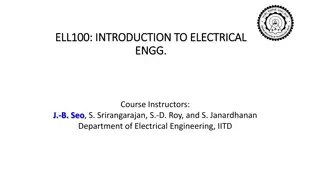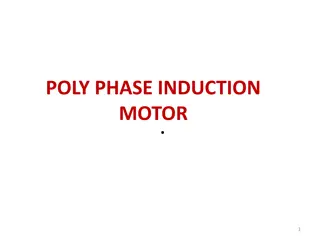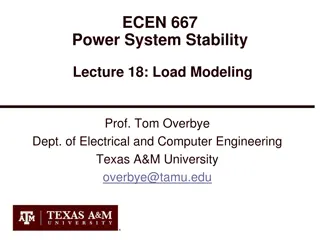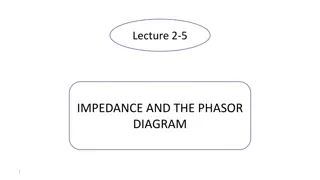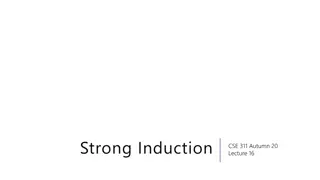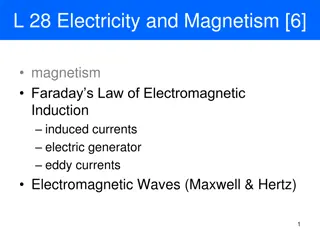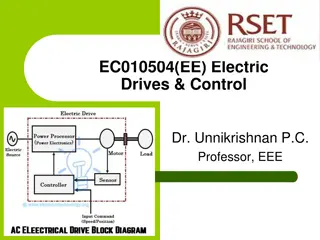Understanding Faraday's Law of Induction and Lenz's Law
Faraday's Law of Induction states that a changing magnetic field induces an electromotive force (emf) in a conductor, producing an induced current. Lenz's Law complements this by determining the direction of the induced current to oppose the change in magnetic field. This phenomenon is demonstrated through Faraday's experiments involving coils, magnets, and galvanometers, showcasing how relative motion between a magnet and a coil leads to induced currents without the need for batteries. The secondary circuit in Faraday's setup detects currents resulting from changes in the magnetic field, emphasizing the link between magnetic fields and induced currents.
Download Presentation

Please find below an Image/Link to download the presentation.
The content on the website is provided AS IS for your information and personal use only. It may not be sold, licensed, or shared on other websites without obtaining consent from the author. Download presentation by click this link. If you encounter any issues during the download, it is possible that the publisher has removed the file from their server.
E N D
Presentation Transcript
Chapter 31 Faraday s Law 31.1 31.2 Faraday s Law of Induction Motional emf
31.1 Faraday s Law of Induction Figure 31.1 (a) When a magnet is moved toward a loop of wire connected to a sensitive ammeter, the ammeter deflects as shown, indicating that a current is induced in the loop. (b) When the magnet is held stationary, there is no induced current in the loop, even when the magnet is inside the loop. (c) When the magnet is moved away from the loop, the ammeter deflects in the opposite direction, indicating that the induced current is opposite that shown in part (a). Changing the direction of the magnet s motion changes the direction of the current induced by that motion.
Lenzs Law The magnet is moving away from the coil so the magnetic field is decreasing, thus the current is in a direction to off-set the decrease. The magnet is moving toward the coil so the magnetic field is increasing, thus the current is in a direction to off-set the increase.
If the magnet is held stationary and the coil is moved toward or away from the magnet, the galvanometer needle will also deflect. From these observations, you can conclude that a current is set up in the circuit as long as there is relative motion between the magnet and the coil. This current is set up in the circuit even though there are no batteries in the circuit. The current is said to be an induced current, which is produced by an induced emf.
Faradays Experiment A coil is connected to a switch and a battery. This is called the primary coil and the circuit is called the primary circuit. The coil is wrapped around an iron ring to intensify the magnetic field produced by the current through the coil. A second coil, on the right, is wrapped around the iron ring and is connected to a galvanometer. This is secondary coil and the circuit is the secondary circuit. There is no battery in the secondary circuit and the secondary circuit is not connected to the primary coil.
The only purpose of this circuit is to detect any current that might be produced by a change in the magnetic field. When the switch in the primary circuit is closed, the galvanometer in the secondary circuit deflects in one direction and then returns to zero. When the switch is opened, the galvanometer deflects in the opposite direction and again returns to zero. The galvanometer reads zero when there is a steady current in the primary circuit. Faraday concluded that an electric current can be produced by a changing magnetic field. A current cannot be produced by a steady magnetic field. The current that is produced in the secondary circuit occurs for only an instant while the magnetic field through the secondary coil is changing. In effect, the secondary circuit behaves as though there were a source of EMF connected to it for a short instant. An induced EMF is produced in the secondary circuit by the changing magnetic field.
In both experiments, an EMF is induced in a circuit when the magnetic flux through the circuit changes with time. Faraday s Law of Induction: The EMF induced in a circuit is directly proportional to the time rate of change of magnetic flux through the circuit. where B is the magnetic flux threading the circuit. d The negative sign is a consequence of Lenz s law (the induced EMF opposes the change in the magnetic flux in the circuit). = B - dt If the circuit is a coil consisting of N loops all of the same area and if the flux threads all loops, the induced EMF is where N is the number of turns in the loops, ( cos t ) BA = = B N N t A is the area of one loop, is the induced emf, and B is the perpendicular component of the magnetic field. = turns # of wire N = B dA B Magnetic flux B :
Suppose the magnetic field is uniform over a loop of area A lying in a plane as shown in the figure below. The flux through the loop is equal to B A cos ; and the induced EMF is: ( ) - d B A cos = dt To induce an emf we can change, the magnitude of B the area enclosed by the loop the angle between B and the normal to the area any combination of the above over time. = = B A 0 B = = B A BA B
Example 31.1 One Way to Induce an emf in a Coil A coil consists of 200 turns of wire. Each turn is a square of side 18 cm, and a uniform magnetic field directed perpendicular to the plane of the coil is turned on. If the field changes linearly from 0 to 0.50 T in 0.80 s, what is the magnitude of the induced emf in the coil while the field is changing?
In which direction is the current induced in the coil for each situation shown? (counterclockwise) (no current)
(counterclockwise) (clockwise)
Rotating the coil about the vertical diameter by pulling the left side toward the reader and pushing the right side away from the reader in a magnetic field that points from right to left in the plane of the page. (counterclockwise)
31.2 Motional emf A motional emf is the emf induced in a conductor moving through a constant magnetic field The electrons in the conductor experience a force, that is directed along q = F v B Under the influence of the force, the electrons move to the lower end of the conductor and accumulate there As a result of the charge separation, an electric field is produced inside the conductor The charges accumulate at both ends of the conductor until they are in equilibrium with regard to the electric and magnetic forces
31.2 Motional emf = F F For equilibrium, qvB vB E = B E = qE or The electric field is related to the potential difference across the ends of the conductor: V = = El Blv A potential difference is maintained between the ends of the conductor as long as the conductor continues to move through the uniform magnetic field If the direction of the motion is reversed, the polarity of the potential difference is also reversed 9/29/2024 16
Sliding Conducting Bar A bar moving through a uniform field and the equivalent circuit diagram Assume the bar has zero resistance The stationary part of the circuit has a resistance R The induced emf is Blx BA B = = d dx dt = = = B B B v dt Since the resistance in the circuit is R, the current is = = BA Blx B R B v R = = I
Sliding Conducting Bar, Energy Considerations The applied force does work on the conducting bar This moves the charges through a magnetic field and establishes a current The change in energy of the system during some time interval must be equal to the transfer of energy into the system by work The power input is equal to the rate at which energy is delivered to the resistor If the bar is moved with constant velocity, IlB F F B app = = R 2 2 2 2 B v R B l v E E = ( ) = = = = = I Fapp v IlB v P P R R d dx dt = = = B B B v dt R B v R = = I
example A rectangular wire loop is pulled thru a uniform B field penetrating its top half, as shown. The induced current : Bout 1. 2. 3. 4. 5. Current CW Current CW, Current CCW, Current CCW, No current, v . No current The motion does not change the magnetic flux, so Faraday s Law says there is no induced EMF, or current, or force, or torque. Of course, if we were pulling at all up or down there would be a force to oppose that motion.
example A circuit in the form of a rectangular piece of wire is pulled away from a long wire carrying current I in the direction shown in the sketch. The induced current in the rectangular circuit is 1. Clockwise 2. Counterclockwise 3. Neither, the current is zero 1. Induced current is clockwise B due to I is into page; the flux through the circuit due to that field decreases as the circuit moves away. So the induced current is clockwise (to make a B into the page)
example A circular flat coil has 200 turns of wire with a total resistance of 25 and an enclosed area of 100 cm2. There is a perpendicular magnetic field of 0.50 T that is turned off in 200 ms. Find the current induced in the coil. The magnetic flux is = BA= (0.50 T)(100 cm2) = (0.50 T)(0.010 m2)= 0.0050 T m2 The change in flux is negative since it is turned off. The induced emf is E = N / t = -(200)(-0.0050 Tm2) / (0.20 s) E = V = 5.0 V The induced current comes from Ohm s Law. I = V/R = (5.0 V) / (25 ) = 0.20 A
Example Consider the circuit .the length of the moving rod is 0.2 m, its speed is 0.1m/s , the magnetic field-strength is 1T ) , and the resistance of the circuit is 0.02 ) 1.What is the emf generated around the circuit? 2.What current flows around the circuit?
3.What is the magnitude and direction of the force acting on the moving rod due to the fact that a current is flowing along it? ILB F 1 1 = = 2 . 0 = 2 . 0 N 4.What is the power delivered by the applied force? Fv P = = = = 1 . 0 = 2 . 0 . 0 02 W 2I P I R






